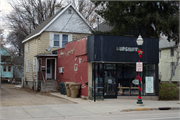| Additional Information: | City of Madison, Wisconsin Underrepresented Communities Historic Resource Survey Report:
A women’s center was originally established in 1970 at the University YMCA at 306 North Brooks Street by people associated with the National Organization for Women and under the banner of the Women’s Liberation Movement. The center lost funding when the United Way of Dane County declined to provide money to an organization that is perceived as “politically leftist.” In 1972, lesbian feminist leaders raised money for the Center by holding special events at venues coordinated by gay liberation groups: St. Francis House Episcopal Student Center at 1001 University Avenue (now 1011 University Avenue) and the Crossroads Gay Center at 301½ N. Hamilton Street.
The group opened the new Women’s Center in the small commercial storefront at 836 E. Johnson Street in the fall of 1972 and immediately began hosting meetings of lesbian groups as well as groups of concerned with general women’s issues. From this location, activists established a strategy for feminist activism in the 1970s and 1980s that included information-sharing, political action, community-building, artistic expression, self-help, and self-publishing. They established a lending library, a lesbian caucus to “work out lesbian/feminist politics,” a regular Thursday-night coffee house, a feminist therapy group, and provided space for a women’s poetry group. The Women’s Center published Whole Woman from this location in 1973 and 1974. From this location, in 1973, the Women’s Center organized the Women’s Transit Authority. The WTA was a network of drivers established, at a time of increased reports of rape, to provide safe transportation for women in the campus and downtown area. The WTA operated at this location until 2006.
As the Gay Liberation Movement evolved in the early 1970s, and lesbian feminists increasingly distanced themselves from NOW and the Women’s Liberation Movement, Madison lesbians saw a need for a women’s center that offered more inclusive services. In 1972, when the United Way decided to stop funding the women’s center at the YMCA, lesbian feminists associated with Madison Gay Sisters used the opportunity to take the women’s center concept, raise money themselves, and open a new Women’s Center in a new location (836 E. Johnson Street). Under lesbian leadership, the Women’s Center established a platform of services that served as a strategy for the Gay Liberation Movement in Madison for the next twenty years: information-sharing, political action, community-building, artistic expression, self-help, and self-publishing. In 1973, the Women’s Center relocated to 550 State Street, sharing space with the Madison Gay Center. The Women’s Center appears to have dissolved in 1974 and been replaced by the Lesbian Switchboard which opened in 1974 in the University YMCA building at 306 North Brooks Street after the Gay Center. |
|---|

